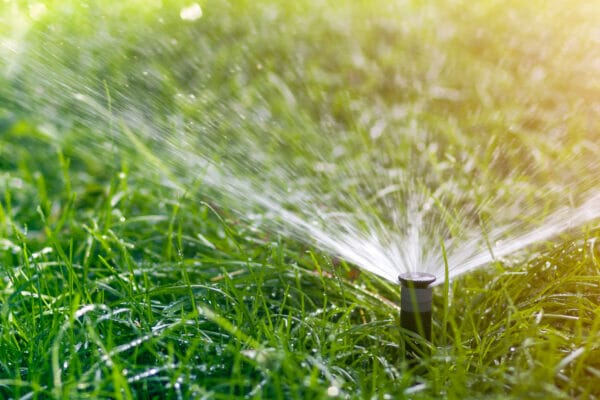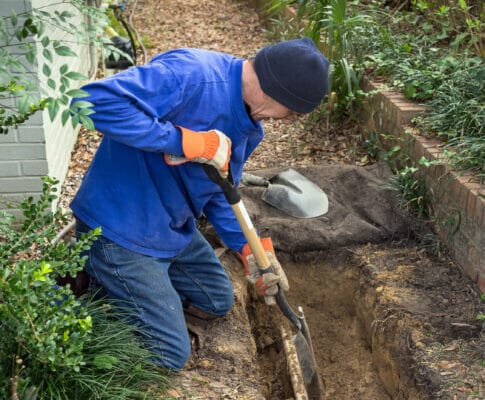Disclaimer: This post may contain affiliate links, meaning we get a small commission if you make a purchase through our links, at no cost to you. For more information, please visit our Disclaimer Page.
When a sprinkler system becomes clogged it can hinder the overall amount of water output and make it difficult to evenly water an area.
Unclogging a sprinkler system starts by identifying the location of the clog. For clog in the sprinkler head, find the filter and remove the debris and dust. For the pipes, you can use a snake, and a hydraulic cleaning tool.

Table of Contents
Why is my sprinkler clogged?
Sprinklers clog due to the debris and dirt buildup. You can spot this debris on the nozzle, head, and screen. Debris finds its way to sit on the sprinkler parts for several reasons. One good example is lawn mowing. When you mow your lawn frequently, the small grasses produced during the mowing may enter the sprinkler parts.
When the grasses pile up, the sprinkler clogs. Take note that clogging only manifests when debris pile up. Monitoring your sprinkler is the easiest way to avoid clogging.
Dirt buildup is the other reason a sprinkler clogs. You can spot this problem when the nozzle is not sliding up properly. In effect, the nozzle stuck up and it does not spray. If you install your sprinkler on an area that accumulates dirt, expect a dirt buildup.
Biological-related problem is another cause of a sprinkler clogging. Irrigation systems create an environment where algae and bacteria clump up and produce bacterial slime. The slime causes clogging of the system.
If the surface water contains other biological organisms or the water contains minerals such as sulfide, iron, and manganese, the chance of clogging increases.
Yet, even without the presence of algae and bacteria, high mineral content causes clogging. The minerals produce suspended solids or precipitate due to low mineral solubility.
When the water has a pH above 7.0 plus a high concentration of minerals, it produces calcium carbonate as a precipitate. Adding fertilizer to hard water also increases mineral precipitation.
How do you clear a clogged sprinkler?
Clearing a clogged sprinkler comes in several ways based on the causes of the clog. I got two ways for you that clean debris, dirt build-up, bacterial slime, and mineral builds up.
Debris and dirt buildup
Debris and dirt build-up is a common problem you can expect for a sprinkler head and nozzle. When cleaning these parts, the first thing you need to do is to locate the filter.
Whatever brand of sprinkler you find in the market, it always has a filter. It may not be in the same place but one thing is sure, a sprinkler comes with a filter.
But before you start cleaning the filter, turn off the sprinkler system. You do not want water to burst while you clean the filter. It is a safety measure that you must always keep in mind.
There are two ways to remove the filter such as popping up the sprinkler head and removing the sprinkler head. You can choose any of these options depending on the situation.
Popping up the sprinkler head
Pop up the sprinkler head and hold it tight so it does not pop back down. While holding the sprinkler head, unscrew the brass tip, then remove the filter.
Clean the tip and the filter with water to remove the debris and dirt build-up.
However, the problem with this method is that the sprinkler pops back down, which makes it hard for you to put back the filter and thread the screw.
If you want to use this method, ask someone to help you clean the filter while you are holding the sprinkler head. You can also use a vise grip to hold the pop-up sprinkler in place.
If you use the vise grip, you do not need assistance.
Removing the sprinkler head
Removing the sprinkler is ideal if you do not have someone with you to clean the filter. It is easier to put back the filter using this method.
To use this method, grab the sprinkler’s body, then turn the cap and take it off to expose the sprinkler head. Remove the rubber gasket to expose the spring inside the sprinkler.
At this point, you can remove the pop-up sprinkler, located inside the spring, by threading the screw. After removing the pop-up sprinkler, clean the filter and the head.
Once you are done cleaning, put back the pop-up sprinkler, then thread the screw. Pop the entire part inside the body, snap the rubber gasket, and screw the cap.
If your sprinkler has a designated orientation, take note of the position.
Mineral buildup
For mineral buildup, you need a brass bristle brush, rust and mineral remover, and spray silicone.
You need these items especially when there is an iron buildup. You must follow the two-step process to remove the buildup such as soaking the sprinkler in rust remover and spraying it with silicone.
Soaking in rust remover
Soak the sprinkler in a freezer bag half full of rust remover. It takes 30 minutes to remove the rust.
For even distribution of the solution, you swish it occasionally. After 30 minutes, rinse the sprinkler in water. Popular rust remover brands include UNRUST, Rust Blocker, and SprinkleRite.
Spraying with silicone
After rinsing the sprinkler, clean off the remaining rust buildup using a brass bristle brush. Spray a silicone lubricant to cover the surface with a hard film, which is stain-resistant.
Popular products for silicone spray include WD-40 Specialist Silicone Quick-Drying, Sprayon, 3M Silicone Lubricant, and Blaster Silicone Lubricant.

How do you find a sprinkler system blockage?
Blockage in a sprinkler system can be found on the sprinkler head and the irrigation pipe. It is easy to find the blockage in a sprinkler head because all you need to locate is the filter. The clump-up of debris and dust is commonly found in the filter.
However, finding the blockage in the irrigation pipe is a bit challenging because sometimes it can be the sewer line that has the problem.
A clogged sewer line may not be able to distribute the water on the pipes, which gives you an impression that your irrigation pipe has the problem.
There are also cases when the irrigation line is broken that you may assume that there is a blockage.
One tool that you can use to find a sprinkler blockage is the fish tape. You need to feed the tape into the pipe until it reaches the clogged part.
You mark the location on the tape where it hits the clog. To use it, you need to find the open end of the pipe. However, if it is not present, you need to cut a section of the pipe, so you can insert the tape.
After the marking, you will find out two scenarios that tell you the real problem. You may find out that the blockage is in the pipe or the tree roots crushed the pipe.
How do you fix a clogged sprinkler system?
Now that you know the reason for the clogging of pipes, let me explain how to fix it. For clog inside the pipe, you can use a snake to remove the clog.
Most of the time, it fixes the problem. However, if the snake gets twisted and jammed, you may need to call a professional to bring a hydraulic cleaning tool.
On the other hand, if the problem is the roots, you may choose between the two options. You can cut the roots and replace a bad pipe. But if the roots are too big to cut, you may need to plan a new route for your pipe.
Conclusion
Clogs on the sprinkler system must not cause you any worry. It is one of the sprinkler system problems that are easy to solve.
Before you panic, start checking the head and nozzle before you go to the pipeline.
Most of the time, you can find the problem in this part. However, if the problem is in the pipeline, it is recommended to hire an expert.
